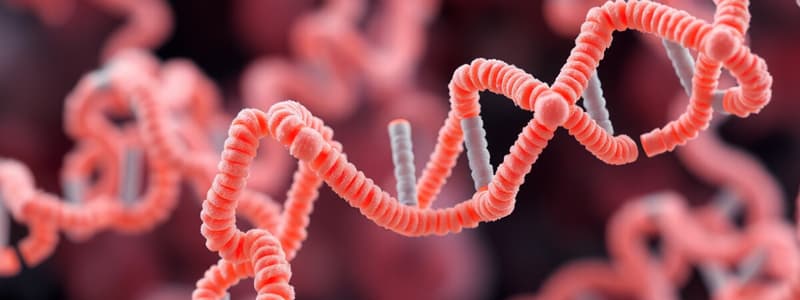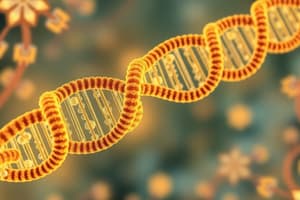Podcast
Questions and Answers
What enzyme is responsible for transcribing DNA into RNA?
What enzyme is responsible for transcribing DNA into RNA?
RNA polymerase
Which base in DNA is replaced by uracil in RNA?
Which base in DNA is replaced by uracil in RNA?
Thymine
What are the two strands of DNA involved in transcription called?
What are the two strands of DNA involved in transcription called?
Coding strand and template strand
How does the mRNA's base sequence relate to the DNA template strand?
How does the mRNA's base sequence relate to the DNA template strand?
Signup and view all the answers
What type of bond forms between the bases of RNA and the DNA template strand?
What type of bond forms between the bases of RNA and the DNA template strand?
Signup and view all the answers
What is the role of mRNA after its formation during transcription?
What is the role of mRNA after its formation during transcription?
Signup and view all the answers
In the transcription of the DNA sequence 'TAC GGA AGA CTT GGG', what will the corresponding RNA transcript be?
In the transcription of the DNA sequence 'TAC GGA AGA CTT GGG', what will the corresponding RNA transcript be?
Signup and view all the answers
What is the significance of having a 'coding strand' in DNA?
What is the significance of having a 'coding strand' in DNA?
Signup and view all the answers
What is the role of RNA polymerase in transcription?
What is the role of RNA polymerase in transcription?
Signup and view all the answers
Where does transcription occur in the cell?
Where does transcription occur in the cell?
Signup and view all the answers
How does mRNA differ from DNA?
How does mRNA differ from DNA?
Signup and view all the answers
What happens to the DNA molecule after transcription is complete?
What happens to the DNA molecule after transcription is complete?
Signup and view all the answers
Why is mRNA referred to as 'messenger' RNA?
Why is mRNA referred to as 'messenger' RNA?
Signup and view all the answers
What triggers the process of transcription?
What triggers the process of transcription?
Signup and view all the answers
What ensures the complementary pairing of RNA nucleotides to DNA during transcription?
What ensures the complementary pairing of RNA nucleotides to DNA during transcription?
Signup and view all the answers
What occurs to mRNA after it is synthesized?
What occurs to mRNA after it is synthesized?
Signup and view all the answers
What is a polypeptide and how is it formed during translation?
What is a polypeptide and how is it formed during translation?
Signup and view all the answers
What is the role of ribosomes in translation?
What is the role of ribosomes in translation?
Signup and view all the answers
How do mRNA and tRNA interact during translation?
How do mRNA and tRNA interact during translation?
Signup and view all the answers
What is the importance of the binding sites on ribosomes?
What is the importance of the binding sites on ribosomes?
Signup and view all the answers
What are the components of a ribosome?
What are the components of a ribosome?
Signup and view all the answers
What initiates the process of translation?
What initiates the process of translation?
Signup and view all the answers
What is the function of tRNA in translation?
What is the function of tRNA in translation?
Signup and view all the answers
What is meant by complementary base pairing in the context of mRNA and tRNA?
What is meant by complementary base pairing in the context of mRNA and tRNA?
Signup and view all the answers
How does transcription compare to translating between two languages?
How does transcription compare to translating between two languages?
Signup and view all the answers
Explain the analogy of translation with converting between languages that use different alphabets.
Explain the analogy of translation with converting between languages that use different alphabets.
Signup and view all the answers
What would be the tRNA anticodon for an mRNA codon with the sequence CAG?
What would be the tRNA anticodon for an mRNA codon with the sequence CAG?
Signup and view all the answers
In the analogy presented, what does the 'alphabet' of nucleic acids refer to?
In the analogy presented, what does the 'alphabet' of nucleic acids refer to?
Signup and view all the answers
What are the main differences between DNA and RNA mentioned in the notes?
What are the main differences between DNA and RNA mentioned in the notes?
Signup and view all the answers
Why is understanding transcription and translation important in molecular biology?
Why is understanding transcription and translation important in molecular biology?
Signup and view all the answers
What role do codons play in the process of protein synthesis?
What role do codons play in the process of protein synthesis?
Signup and view all the answers
What is a gene mutation, and what can it result in?
What is a gene mutation, and what can it result in?
Signup and view all the answers
Describe how point mutations can affect polypeptide structure.
Describe how point mutations can affect polypeptide structure.
Signup and view all the answers
Explain why mutations in normal body cells are not inherited.
Explain why mutations in normal body cells are not inherited.
Signup and view all the answers
What is the consequence of a mutation leading to sickle cell disease?
What is the consequence of a mutation leading to sickle cell disease?
Signup and view all the answers
How does the sickle cell mutation change the DNA triplet sequence?
How does the sickle cell mutation change the DNA triplet sequence?
Signup and view all the answers
What is the role of mutations during DNA replication?
What is the role of mutations during DNA replication?
Signup and view all the answers
List the two types of effects mutations can have on an organism.
List the two types of effects mutations can have on an organism.
Signup and view all the answers
What happens to a polypeptide when a point mutation changes an amino acid?
What happens to a polypeptide when a point mutation changes an amino acid?
Signup and view all the answers
What is the primary result of a base substitution in the DNA molecule related to haemoglobin?
What is the primary result of a base substitution in the DNA molecule related to haemoglobin?
Signup and view all the answers
How do sickle-shaped red blood cells impact oxygen delivery in the body?
How do sickle-shaped red blood cells impact oxygen delivery in the body?
Signup and view all the answers
What are the implications of sickle cell anaemia on blood flow?
What are the implications of sickle cell anaemia on blood flow?
Signup and view all the answers
Discuss the relationship between sickle cell disease and malaria.
Discuss the relationship between sickle cell disease and malaria.
Signup and view all the answers
What causes the distortion in shape of red blood cells in sickle cell anaemia?
What causes the distortion in shape of red blood cells in sickle cell anaemia?
Signup and view all the answers
What are some common symptoms experienced by individuals with sickle cell anaemia?
What are some common symptoms experienced by individuals with sickle cell anaemia?
Signup and view all the answers
Explain how sickle cell alleles provide a selective advantage in certain regions.
Explain how sickle cell alleles provide a selective advantage in certain regions.
Signup and view all the answers
What structural change occurs in the polypeptide caused by a base substitution?
What structural change occurs in the polypeptide caused by a base substitution?
Signup and view all the answers
Study Notes
SL IB Biology - Protein Synthesis
-
Protein synthesis is a two-stage process:
- Transcription
- Translation
Transcription in Protein Synthesis
-
Synthesis of RNA
- DNA is transcribed to produce mRNA; mRNA carries the genetic code from the DNA to the cytoplasm
- mRNA production requires RNA polymerase
- Transcription occurs in the nucleus of the cell
- A section of DNA unwinds (hydrogen bonds break)
- Complementary RNA nucleotides bind to the exposed DNA strand
- The enzyme RNA polymerase joins these RNA nucleotides to form the mRNA molecule
- The mRNA molecule leaves the nucleus through nuclear pores
- The original DNA strands reform hydrogen bonds
- DNA polymerase is not involved in transcription; RNA polymerase is
-
The Process of Transcription
- Part of a DNA molecule unwinds
- The exposed gene is transcribed
- Free RNA nucleotides pair up with the DNA template strand by hydrogen bonds
- RNA polymerase joins the RNA nucleotides forming the mRNA molecule
- The hydrogen bonds between DNA and mRNA break
- The mRNA leaves the nucleus
-
Examiner Tip: Be careful, DNA polymerase is involved in DNA replication, not transcription. RNA polymerase is the enzyme involved in transcription.
The Genetic Code
-
The sequence of DNA bases is determined by a triplet code
-
Each triplet (three bases) codes for a specific amino acid
-
There are 20 different amino acids
-
Some triplets act as start and stop signals
-
Examples:
- CAG codes for Valine
- TTC codes for Lysine
- GAC codes for Leucine
- CCG codes for Glycine
-
Features of the Genetic Code
- Non-overlapping; each base only read once in a codon
- Degenerate; multiple codons may code for the same amino acids
- Universal; almost all organisms use the same code
-
mRNA codons and amino acids: A table is used to deduce the amino acid coded by an mRNA sequence.
Protein Structure & Mutations
-
A gene mutation is a change in the DNA base sequence
-
Mutations occur randomly during DNA replication; some are harmful, others neutral and some beneficial
-
Mutations in genes for polypeptides can lead to changes in the amino acid sequence of the protein
-
Point mutations are changes in a single DNA base
- Can lead to a change in the amino acid at that position
-
Example: Sickle cell anaemia
- GAG (coding strand) mutation to GTG (coding strand)
- This results in the amino acid Valine replacing Glutamic Acid.
- This alteration causes a change in the structure of haemoglobin (a protein), and hence the shape and function of red blood cells, causing sickle-cell anemia symptoms.
Studying That Suits You
Use AI to generate personalized quizzes and flashcards to suit your learning preferences.
Related Documents
Description
Test your knowledge on the process of protein synthesis, focusing on transcription. This quiz covers key concepts such as the roles of RNA polymerase and the steps involved in synthesizing mRNA from DNA. Challenge yourself with questions about the mechanisms and importance of this vital biological process.




